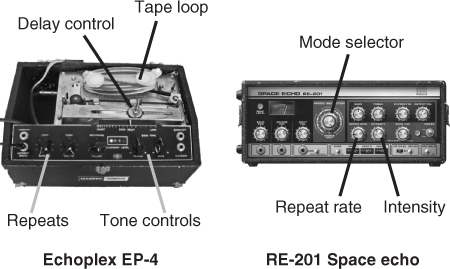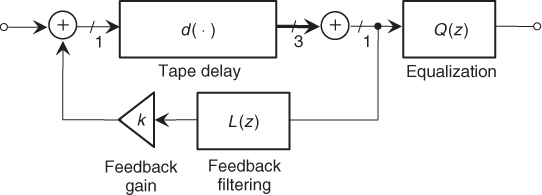12.5 Tape-based Echo Simulation
12.5.1 Introduction
In this section, we turn our attention to simulating tape echo, focusing on two popular units, the Roland Space Echo, used widely in dub and reggae music, and the Maestro Echoplex, popular among guitarists.
The Echoplex was first released in 1959. Four versions were made, the EP-1 and EP-2 employing tube circuitry, and the EP-3 and EP-4 using solid-state electronics. An EP-4 is shown in Figure 12.21, and its signal flow architecture in Figure 12.22. Playback and erase heads are fixed on either side of a slot along which the record head is free to move. The record head writes to the moving tape, and the recorded signal is later read as the tape passes by the playback head. Moving the delay control changes the distance between the record and playback heads, and, therefore, the time delay between input and output. With a nominal tape speed of 8 ips, delays roughly in the range of 60 ms to 600 ms are available.
Figure 12.21 Maestro Echoplex EP-4 (left) and Roland RE-201 Space Echo (right).

Figure 12.22 Tape Delay Signal Flow Architecture. The Space Echo provides up to three separate delays which are summed (as shown); the Echoplex features a single delay.

As seen in Figure 12.22, the input signal is delayed and fed back, with the ...
Get DAFX: Digital Audio Effects, Second Edition now with the O’Reilly learning platform.
O’Reilly members experience books, live events, courses curated by job role, and more from O’Reilly and nearly 200 top publishers.

